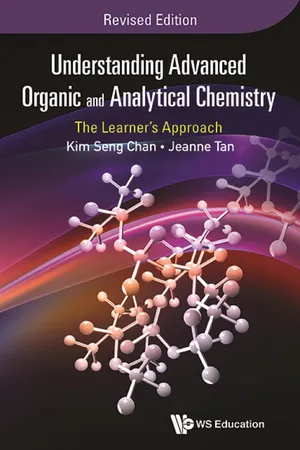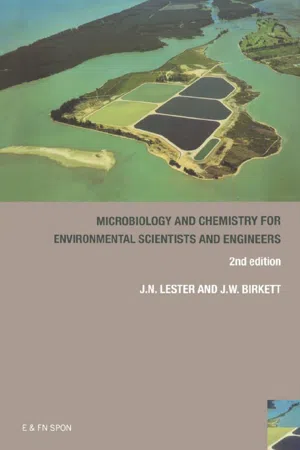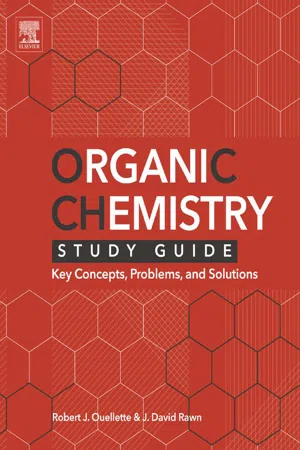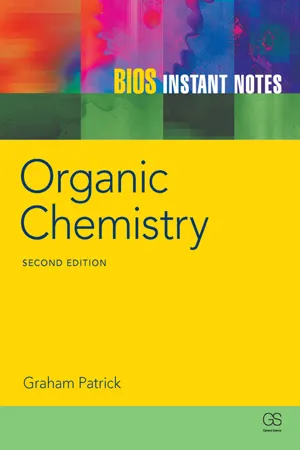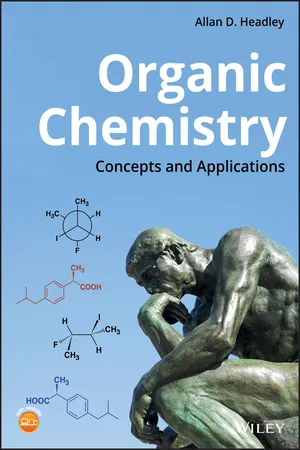Chemistry
Haloalkane
Haloalkanes are organic compounds containing one or more halogen atoms (fluorine, chlorine, bromine, or iodine) bonded to an alkane carbon atom. They are commonly used as solvents, refrigerants, and as intermediates in organic synthesis. Haloalkanes are known for their reactivity in substitution and elimination reactions, making them important in organic chemistry.
Written by Perlego with AI-assistance
Related key terms
Related key terms
1 of 4
Related key terms
1 of 3
7 Key excerpts on "Haloalkane"
- eBook - ePub
Understanding Advanced Organic and Analytical Chemistry
The Learner's ApproachRevised Edition
- Kim Seng Chan, Jeanne Tan;;;(Authors)
- 2016(Publication Date)
- WS EDUCATION(Publisher)
CHAPTER 7
Halogen Derivatives
7.1 Introduction
Halogenoalkanes, also known as alkyl halides, are saturated organic compounds that contain the −C−X functional group (X = F, Cl, Br or I). They are important derivatives of alkanes and have the general formula Cn H2n+1 X. An example is bromoethane:Halogenoalkanes do not occur naturally. In fact, they are the by-products of the reaction of alkanes or alkenes with halogen, as these hydrocarbons are commonly found in petroleum. Halogenoalkanes are generally known as the “workhorse” in organic chemistry as they are very useful intermediates to be converted to other more important specialty chemicals of greater economic value. Some halogenoalkanes, such as chlorofluorocarbon, can also be harmful to the environment.Halogenoarenes (or aryl halides) are aromatic compounds with a halogen atom directly attached to the benzene ring. Similar to halogenoalkanes, halogenoarenes do not occur naturally and are in fact synthesized by reacting aromatic compounds isolated from petroleum with halogens.7.2 Nomenclature
A halogenolkane is obtained when one or more hydrogen atoms of an alkane molecule have been replaced by halogen atoms via the free radical substitution reaction. Other than this, halogenoalkanes can also be obtained when hydrogen halide (HX) or the diatomic halogen molecules add across an alkene double bond through the electrophilic addition mechanism. Thus, one can simply perceive halogenoalkanes as substituted alkanes. Therefore, halogenoalkanes are named in a similar manner to alkanes — the suffix ends in — ane - Jason Birkett, John Lester(Authors)
- 2018(Publication Date)
- CRC Press(Publisher)
alkanamides using the same systematic approach utilized in the naming of amines. Like amines, there can be primary, secondary and tertiary amides.One important reaction of amides is the Hofmann rearrangement. In this halogenation reaction, the carbonyl group is removed from the molecule to produce an amine containing one less carbon atom in the chain. This is shown below:7.4.3 Halogenated organic compounds These compounds (called Haloalkanes) are used frequently in organic synthesis. They can pose a significant environmental threat as they are generally toxic to humans. Simple Haloalkanes have the general formula R—X, R being the organic substituent. The common names for these compounds are alkyl halides.One example of a simple Haloalkane is chloroethane, C2 H5 Cl, its common name being ethyl chloride. This compound is used to produce tetraethyl lead ((C2 H5 )4 Pb), a compound used as an anti-knocking agent in petrol.Many polyhalogenated compounds are utilized in industry as solvents, paint strippers, pesticides and so on. Many of these substances are highly toxic, with some being carcinogenic. Examples of polyhalogenated compounds are chloroform (trichloromethane, CHCl3 ), carbon tetrachloride (tetrachloromethane, CCl4 ) and chlorofluorocarbons (CFCs).Aromatic compounds are so named due to their strong aroma. They can be classed as those compounds which contain a benzene ring structure.7.5 Aromatic compounds
Benzene (C6 H6 ) is an unusually unreactive compound and its electronic arrangement gives it this stability both thermodynamically and kinetically. The electrons in the double bonds (p electrons) are delocalized, i.e. spread around the entire ring system. Thus, benzene is often represented by structure III in Fig. 7.15 and is considered to be the “parent” aromatic molecule. Owing to its alternate double bonds in the ring, benzene is said to exhibit conjugation- eBook - ePub
Organic Chemistry Study Guide
Key Concepts, Problems, and Solutions
- Robert J. Ouellette, J. David Rawn(Authors)
- 2014(Publication Date)
- Elsevier(Publisher)
9Haloalkanes and Alcohols Introduction to Nucleophilic Substitution and Elimination Reactions
Keys to the Chapter
9.1 Functionalized Hydrocarbons
In this chapter, we discuss the chemistry of Haloalkanes and alcohols in which the halogen or hydroxy! group is bonded to an sp3 -hybridized carbon atom. Molecules with sp2 -hybridized carbon atoms bonded to a halogen or a hydroxyl group have different chemistry. We will discuss these compounds in later chapters. Haloalkanes and alcohols are classified as 1°, 2°, and 3° by the same method used to classify carbon atoms in alkanes.9.2 Nomenclature of Haloalkanes
The rules for naming Haloalkanes are very similar to the rules for naming alkanes (Section 4.3 ) and alkenes (Section 5.6 ). Halogen atoms and branching alkyl groups have equal priorities in terms of their positions in the parent chain. If no other functional groups are present, the chain is numbered from the end closest to the first substituent, whether it is a halogen or an alkyl group. However, the double bond of an alkene or the triple bond of an alkyne takes precedence in numbering a carbon chain, regardless of where the halogen is located or how many halogens there may be. The concept of the priority of one functional group over another is expanded with each new functional group we will study in later chapters. It is explicitly part of R ,S configurational nomenclature.9.3 Nomenclature of Alcohols
The common names of simple alcohols are based on the name of the alkyl group bonded to the hydroxyl group, as in methyl alcohol. The IUPAC method of naming alcohols is based on the longest continuous carbon chain that contains a hydroxyl group. The chain is numbered to give the carbon atom bonded to the hydroxyl group the lowest possible number. The suffix -ol - eBook - ePub
- Graham Patrick(Author)
- 2004(Publication Date)
- Taylor & Francis(Publisher)
SECTION L — ALKYL HALIDESL1 Preparation and physical properties of alkyl halides
Key Notes
Preparation Alkenes are converted to alkyl halides by reaction with hydrogen halides. Treatment with halogens results in diHaloalkanes. Tertiary alcohols can be converted to alkyl halides on treatment with hydrogen halides, whereas primary and secondary alcohols are best converted by using thionyl chloride or phosphorus tribromide. Structure Alkyl halides consist of an alkyl group linked to a halogen. The carbon linked to the halogen is sp 3 hybridized and tetrahedral. The carbon–halogen bond length increases and the bond strength decreases as the halogen increases in size. Bonding The C–halogen bond (C–X) is a polar σ bond where the halogen is slightly negative and the carbon is slightly positive. Intermolecular bonding is by weak van der Waals interactions. Properties Alkyl halides have a dipole moment. They are poorly soluble in water, but dissolve in organic solvents. They react as electrophiles at the carbon center. Reactions Alkyl halides undergo nucleophilic substitution reactions and elimination reactions. Spectroscopic analysis The presence of a halogen atom can be shown by IR spectroscopy (C–X stretching absorptions) as well as by mass spectrometry. The latter shows a characteristic pattern of peaks for the molecular ion that matches the number and ratio of naturally occurring isotopes of the halogen. Elemental analysis also demonstrates the presence of halogens. Related topics (A3) sp 3 Hybridization (C3) Intermolecular bonding (C4) Properties and reactions (H3) Electrophilic addition to symmetrical alkenes (M4) Reactions of alcohols (P3) Infra-red spectroscopy (P4) Proton nuclear magnetic resonance spectroscopy (P6) Mass spectrometry Preparation
Alkenes can be treated with hydrogen halides (HCl, HBr, and HI) or halogens (Cl2 and Br2 ) to give alkyl halides and diHaloalkanes respectively (Section H3 ). An extremely useful method of preparing alkyl halides is to treat an alcohol with a hydrogen halide (HX = HCl, HBr, or HI). The reaction works best for tertiary alcohols (Section M4 ). Primary and secondary alcohols can be converted to alkyl halides more effectively by treating them with thionyl chloride (SOCl2 ) or phosphorus tribromide (PBr3 - eBook - ePub
- Andrew F. Parsons(Author)
- 2013(Publication Date)
- Wiley(Publisher)
5 Br.- An alicyclic halogenoalkane has the carbon atoms in a closed ring, but the ring is not aromatic, e.g. bromocyclohexane, C6 H11 Br.
- An aromatic halogenoalkane has the carbon atoms in a closed ring and the ring is aromatic, e.g. bromobenzene, C6 H5 Br.
The formation of bromobenzene from benzene is discussed in Section 7.2.15.2 Preparation
5.2.1 Halogenation of Alkanes
Chloroalkanes (RCl) or bromoalkanes (RBr) can be obtained from alkanes (RH) by reaction with chlorine or bromine gas, respectively, in the presence of UV radiation. The reaction involves a radical chain mechanism.Radicals are introduced in Section 4.1 Radical reactions are discussed in Section 4.6.2This is a substitution reaction as a hydrogen atom on the carbon is substituted for a Cl or Br atom. A mixture of halogenated products is usually obtained if further substitution reactions can take place.Chloroalkanes, such as CH2 Cl2 (dichloromethane), are common solvents in organic synthesisPrimary, secondary and tertiary halogenoalkanes are defined in Section 2.1The ease of halogenation depends on whether the hydrogen atom is bonded to a primary, secondary or tertiary carbon atom. A tertiary hydrogen atom is more reactive because reaction with a halogen atom (X• ) produces an intermediate tertiary radical, which is more stable (and therefore more readily formed) than a secondary or primary radical (Section 4.3).5.2.2 Halogenation of Alcohols
Alcohols (ROH) are converted into halogenoalkanes using a number of methods. All methods involve ‘activating’ the OH group to make this into a better leaving group (Section 5.3.1.4). Reaction mechanisms are introduced in Section 4.11The mechanism of these reactions depends on whether a primary (RCH2 OH), secondary (R2 CHOH) or tertiary alcohol (R3 - eBook - ePub
Organic Chemistry
Concepts and Applications
- Allan D. Headley(Author)
- 2019(Publication Date)
- Wiley(Publisher)
14 Free Radical Substitution Reactions Involving Alkanes14.1 Introduction
Saturated hydrocarbons, also called alkanes, are fairly unreactive, but they do undergo some reaction types mentioned in Chapter 6 . We have seen that most alkanes readily undergo oxidation under specific reaction conditions to liberate heat, along with water and carbon dioxide. In this chapter, we will examine another reaction type that alkanes undergo, and that is substitution reactions. Substitution reactions involving different types of alkanes with chlorine or bromine in the presence of energy in the form of heat or light to form much more reactive compounds, alkyl halides will be examined. Alkyl halides are used frequently for the synthesis of larger and other useful compounds, which will be covered in this chapter. We have already covered some of the reactions of alky halides, which include elimination reactions. Alkyl halides are alkanes in which one or more of the hydrogens of the alkanes has been substituted for one or more halogens. The usual representation of alkyl halides is R‐X, where R represents the alkyl group, and X represents the halogen. Some alkyl halides are used as solvents in organic and industrial labs. Such halogenated solvents are immiscible with water and are denser than water (Figure 14.1 ).Chloroform was one of the first compounds discovered to induce general anesthesia. The use of this compound opened the possibility to perform surgery on patients who became unconscious when vapors of chloroform were inhaled. It was later discovered that chloroform is toxic and carcinogenic, so its use for this purpose was stopped. Several compounds, such as N2 O and BrClCHCF3 , have been used instead. Over the years, less toxic alkyl halides, such as ethyl chloride haloethane and isoflurane, were used.Chlorofluorocarbon s (CFC s) are very volatile compounds, and they were used as the propellant for aerosols in deodorants, paints, hair spray, and other spray products. They are also called Freon and are used as refrigerants in air conditioners, refrigerators, and freezers. Since these CFCs are inert compounds, they were considered ideal volatile propellants until in the 1970s, it was discovered that they ultimately find their way to the stratosphere where they deplete the ozone (O3 - eBook - ePub
- Jeffrey Gaffney, Nancy Marley(Authors)
- 2017(Publication Date)
- Elsevier(Publisher)
a saturated hydrocarbon forming one continuous chain of carbon atoms bonded together in a straight line where each carbon atom is bonded to no more than two other carbon atoms.Organohalide a class of organic compounds containing one or more halogen atom substituted for a hydrogen atom.Polymer a large molecule made up of carbon chains or rings with linked repeating subunits, which are called monomers.Saponification a reaction in which an ester is heated with a strong base to produce a free alcohol and an acid salt such as the alkaline hydrolysis of a fatty acid ester contained in animal fat to make soap.Saturated hydrocarbona hydrocarbon containing only sp 3 hybridized σ bonds where each carbon is bonded to the maximum number of four neighboring carbon or hydrogen atoms.Steric hindrance the interference of a reaction mechanism caused by the interaction of a reactant with other large groups near the functional group taking part in the reaction.Stereochemistry the study of the three-dimensional arrangement of atoms in a molecule and the effect on chemical reactions.Structural isomers molecules that have the same molecular formula but have different bonding patterns and atomic arrangement.Substitution reaction an organic chemical reaction involving the displacement of one functional group by another functional group in a molecule.Syndiotactican sp 3 hybridized polymer with the substituent group on alternate sides of the polymer chain.Tacticitythe order of the branched alkyl groups on the backbone of sp 3
Index pages curate the most relevant extracts from our library of academic textbooks. They’ve been created using an in-house natural language model (NLM), each adding context and meaning to key research topics.
Explore more topic indexes
Explore more topic indexes
1 of 6
Explore more topic indexes
1 of 4
